Despite their small size, pet rats possess an exceedingly high level of intelligence. With their clever minds, rats know when you’ve arrived home, come when called along with easily learning various amusements such as bowling, food puzzles and other tricks, and, yes, they can even learn to use litter boxes.
Pet rat litter training inside their cage
Supplies Needed
Litter boxes:
- Corner litter boxes work great. They come in both jumbo and regular sizes.
- You can also use just plain old baking pans.
- Make your own litter boxes out of cardboard trays or shoe box tops. Pizza boxes split in half make fantastic litter boxes. The best sizes to buy are the 8” and 10” sizes, depending on how large your cage is.
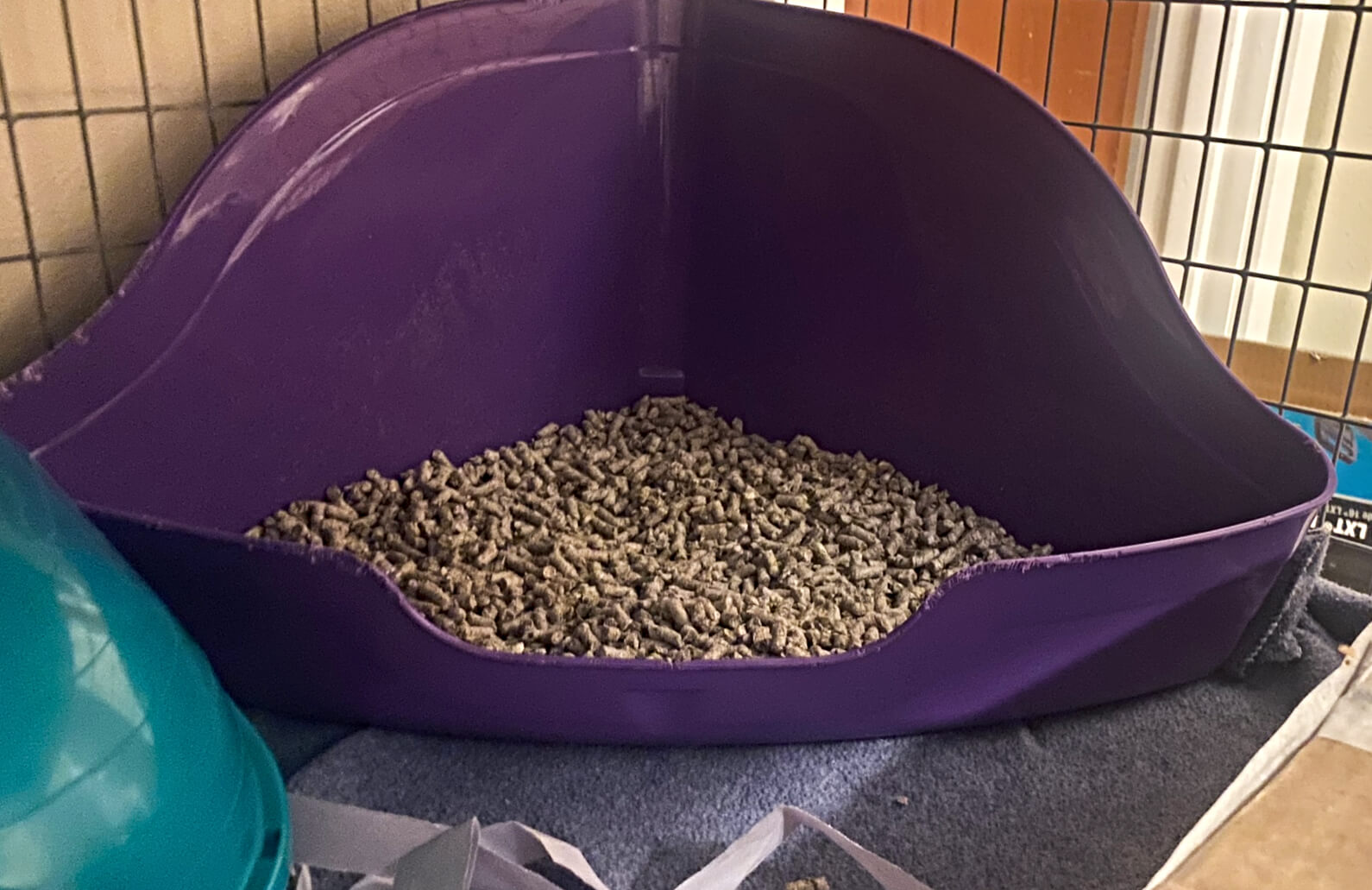
Litter:
- Fresh News
- Integrity Cobbled Paper Recycled Biodegradable Cat Litter
- Unbleached paper towels: They’re less dusty and can be somewhat easier to clean up than actual litter. (If using paper towels as “litter”, you may need to use masking tape to secure the towels so your rats don’t drag them off to use as bedding.)
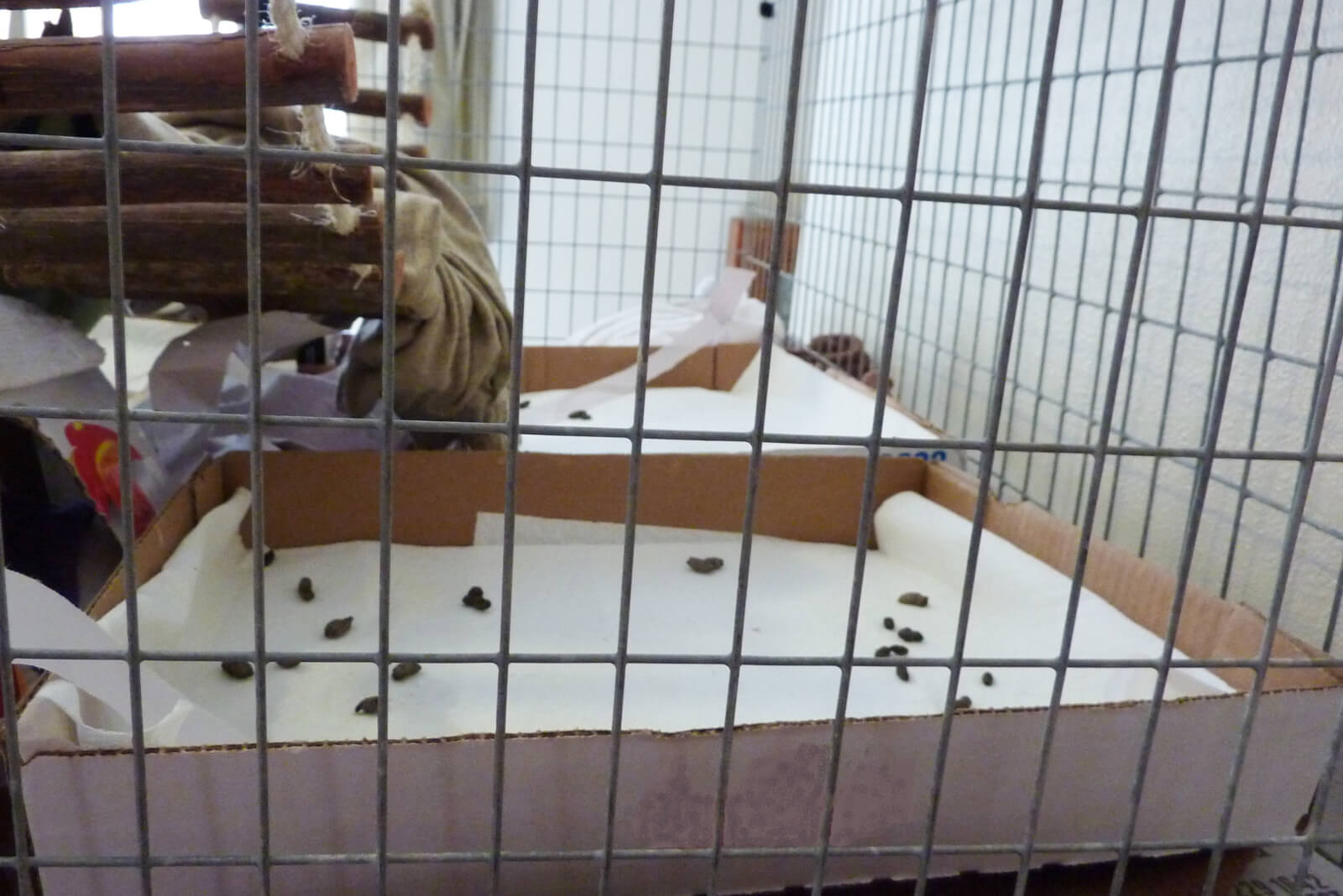
When first starting out with litter box training your rats, place a litter box in every corner of each level of their cage.
The following recommendations will help your rats learn how to use their litter boxes:
- Initially, you may find they defecate outside their boxes. If this happens, place additional litter boxes in the locations where they’ve defecated. (Later, they’ll get the message and will most likely use the litter boxes you originally placed in the corners of their cage.)
- If you find any feces outside of a litter box, pick them up and place them inside the nearest litter box. If possible, do this while your rats are inside their cage and when they can see what you’re doing. This helps demonstrate the desired behavior. While doing so, it helps to say gently and pleasantly “litter box” or “paper towel” or whatever words you’d like to use to be associated with their litter boxes. The idea is you’re not trying to punish them, but rather are calmly pointing out that their poop belongs in the litter box.
- If you see them start to defecate or urinate in an area other than their litter box, gently scoop them up and place them inside their nearest litter box. While doing this, say “litter box” or “paper towel” (or whatever words you’ve chosen) so, again, they associate these words with using their litter box.
- Whenever you see them using their litter box, praise them. They love positive feedback and it really does help reinforce the behavior. When praising them you can also use the words “litter box” or “paper towels”. For example: “Good litter box!” or “Good paper towels!”
Litter boxes should be cleared of all poop and urine at least once daily. This is extremely important. Your rats can become seriously ill if urine and feces are not cleaned up regularly. If you’re using paper towels, you’ll need to replace all soiled towels with fresh, clean ones each day. If you’re using litter, pick up all the poop and scoop out any urine-soaked litter on a daily basis. Add more litter as needed to keep the litter box adequately filled.

Pet rat litter training outside their cage
After they’re litter box trained inside their cage, you can start litter training them outside their cage, too. Outside the cage, I find it easier to use paper towels rather than litter boxes.
Wherever you take your rats, strategically place folded up layers of paper towels in areas where they’d be most likely to urinate and defecate. Generally 3-5 paper towels in a stack are a good number to be absorbent enough so that the surface underneath doesn’t get soiled.
If your rats are on a sofa: Place paper towels in the inner corners at either end
If your rats are exploring the floor of a room: Place paper towels in each corner of the room as well as any other area that looks like a desirable bathroom spot for your rats. When letting your rats play in a room outside their cage, be sure that the room has already been rat-proofed and set up safely.
To get started with litter training outside your rats’ cage, here are some tips that will help:
- The moment you take your rats from their cage to your couch or out to play in a room, place them immediately onto the paper towels and say “paper towel” (or “litter box” if you’re using litter boxes inside their cage) even if they don’t need to go to the bathroom. After you’ve placed them on the paper towels, you can let them walk around and explore. In most cases, they’ll automatically use the paper towels as their bathroom, especially if they’ve already been trained to do so when inside their cage. (Some rats will even go inside their cage litter box if they need to eliminate during free range time.
- In the beginning, if you find them defecating or urinating on your couch or carpet or wherever you have them, use the same method you used inside their cage: If they begin urinating or defecating in the “wrong place”, gently pick them up and move them onto the paper towels and say “paper towel” or “litter box”. Allow them to finish eliminating on the paper towels.
- Also, same as you did while they were learning to use litter boxes inside their cage, If they start to poop or pee on the couch or carpet where there isn’t already a stack of paper towels, place additional paper towels in the location(s) they’ve chosen for themselves.
- Again, always praise them when you see them using the words “litter box” or “paper towels”.
While your rats are on your shoulder
If you’re walking around with your rats on your shoulders, they’ll usually let you know when they have to go to the bathroom. They’ll get “antsy” and act as if they want to get off your shoulder. It’s easy to think they’re just not happy being on your shoulders if they’re getting squirmy. Most of the time, though, it just means they need to use the bathroom.
When this happens, simply take your rat off your shoulder and place him or her on paper towels you’ve already placed nearby. For example, if you’re in your kitchen, have paper towels in the corner of one of your counter tops. Always have a stack of paper towels ready nearby wherever you go with your rats inside your house in case they need to use them.
If you’re outside your home or in your car, have a cat carrier or small cage ready with a stack of paper towels placed in the back of it. Again, if they start trying to get off your shoulder, place them inside the cat carrier with the paper towels. After your rats use the bathroom in their carrier or cage, they’ll usually be eager to get back on your shoulder and will no longer try to get off.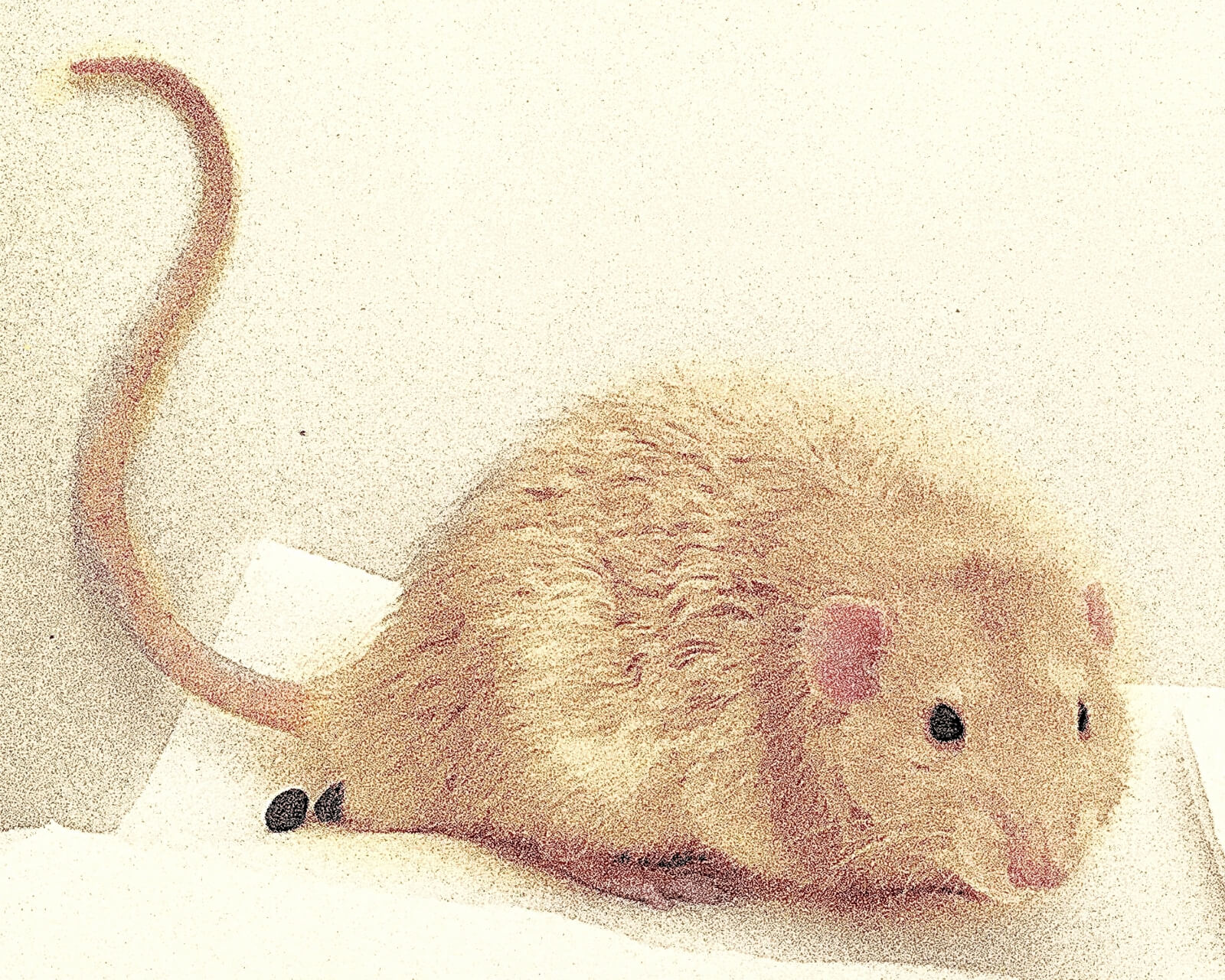
How to help your rats learn to urinate (not just defecate) in their litter boxes
Inside the cage, it can be more difficult to teach urinating in the litter box. After all, it’s easy to pick up “poop” and place it in the right spot to show them how it’s done, but you can’t do that with urine. This is when it comes in handy to observe your rats right when they’re about to urinate. Even though they’re already low to the ground, you can tell they’re about to pee when they squat and hold still. If they’re not already inside a litter box when beginning to urinate, gently pick them up and place them in a litter box and praise them while they finish urinating.
One method that works really well is to gently pick them up while they’re sleeping and place them in a litter box. Use the words you’ve chosen and praise them. (“Good litter box” or “Good paper towels.) This works well since rats usually need to urinate as soon as they wake up, just like humans. (I don’t normally advocate picking up a rat when they’re sleeping but this is a well-justified exception.)
Rats really enjoy learning and it’s incredibly fun and rewarding to train them. After you finish training your rats to use litter boxes, you’ll be very glad you did.
This post contains affiliate links. When you make a purchase through some of our links About Pet Rats receives a small commission at no extra cost to you. Your support is greatly appreciated and helps maintain this website and our ability to help pet rat owners around the world.
Updated 3/22/23
You may also be interested in reading:
Litter Box Literacy: The finer points of teaching pet rats to urinate in litter boxes


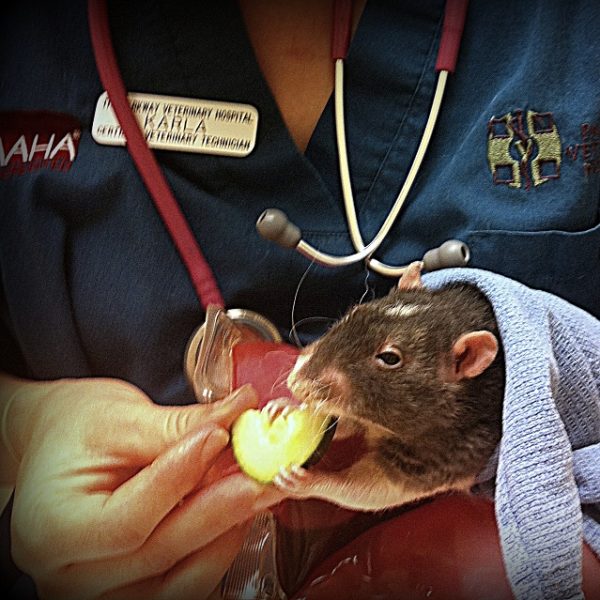
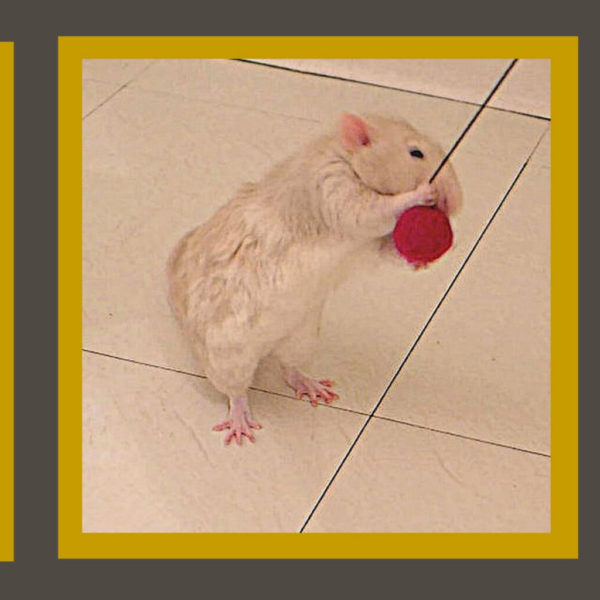



Hi Jasmine! I have 3 females about 3 months old, I have had them for 1 month. They used their litterbox great for the first week or two until they discovered tunneling under the fleece! I know this is natural instinct and I want to provide that experience for them. Unfortunately now they are just peeing and pooping between the layers and hardly come out. I try being patient, they used to come out and crawl out the door to come see me. Now I have to reach under and pick them up. They will burrow in my hair and clothes, but one is particularly shy and doesn’t crawl on me at all, she just hides while I pet her. Only the most outgoing is treat motivated and likes to crawl on me. Please help!!
-Jennifer
Hi Jennifer,
That’s fantastic your rats used their litterbox perfectly for the first week or two. That shows you at least they know how to use their litter boxes.
I recently had the same problem! My rats were going underneath the fleece and were sleeping and peeing in between the layers of their fleece and the washable pee pads I use to protect their cage. I, too, was wondering how I was going to get them to stop doing this.
I’m thankful I figured out a way to keep them from burrowing underneath the fleece on the floor of their cage. You’ll never believe what’s stopped them: Their Pirate Ship. Whenever I have their pirate ship hanging in their cage they jump right in and don’t want to come out unless they need to eat or use the litter box.
So, the answer is to find hideouts/hanging beds they can’t resist being inside. You need to find something that’s even more comfy-cozy than burrowing underneath the fleece. You’ll need to experiment a bit to find what will appeal to them. I’m confident you can find something they’ll like better than being underneath the fleece.
I find that these types of problems are usually temporary. Once you do get them sleeping in their Pirate Ship or whatever bed you find they can’t resist, make sure to continually praise them when they use their litter box. It really helps reinforce their positive behavior. Also, whenever you greet them after they’re awakening, place them in the litter box and praise them while they’re in there. They’ll get the message.
Keep in mind you’ve only had your rats for one month! And they’re only 3 months old! It really does usually take several months for them to get acclimated to you. Also, since they’re girls, they tend to be more hyperactive and independent especially when they’re babies. Just keep spending as much time as you can with them, and they’ll get used to you and start to warm up to you over time.
Have you tried having all 3 out on your shoulder while you walk with them somewhere away from their cage? You can sit with them on the couch, and they can snuggle up inside your shirt. Your shy one will learn from the other two.
If you haven’t already read them, here are 2 posts you might find helpful for socializing your rats:
Shy Rats Transformed: from Shy to Social Butterfly
Bonding with Your Pet Rats in Three Easy Steps
Don’t hesitate to let me know if you have any further questions and/or need any clarification on what I’ve written.
Best Wishes to You & Your Rats,
Jasmine | About Pet Rats
P.S. When you purchase anything from Amazon through the above Pirate Ship link, About Pet Rats receives a small commission at no extra cost to you. Your support is greatly appreciated!
Hi! Thank you so much for this article! I have three female baby ratties (a bit over a month old). When should I start litter training? I have two litter boxes in the cage, one for each level, but they just poop literally EVERYWHERE. I move the poop into the box, but it hasn’t been doing much. They also try to hide their food in the box. Any tips? Thanks!
Hi Leah,
Starting litterbox training right away is the best way to go. It sounds like you’re off to a great start. That’s good that you’re moving the poop into their boxes.
If you find they’re still pooping everywhere, I would…..
1. Initially use more litter boxes. At least double the number you’re using now. Place the boxes in all locations where they’re currently pooping.
2. If you find they’re not using their current litter boxes at all, move them to the locations where they are pooping. Eventually they’ll choose fewer boxes in which to urinate/defecate. For now, though, you need to demonstrate to them that the litter boxes are where the poop needs to go.
3. Sometimes it really helps if they see you placing their poop in the boxes—-I’d make sure to at least some of the time move their poop into a litter box when they’re observing you. You can say aloud “litter box” while you’re placing their poop in the boxes.
4. During their training period I would also be around them a lot right after they’ve eaten. That way you’re more likely to be able to catch them when they’re about to poop and place them immediately inside their litter boxes so they do it in the correct place.
5. When you do see them about to squat (when they’re about to defecate):
a. Praise them if they’re already in their box. (Again, as mentioned in my post above, I like to say something such as “litter box” aloud to them in a soft, positive voice.)
b. If they’re not already in their box, pick them up and place them inside a litter box so they do end up pooping in the box. Again, verbally praise them when they do poop in the box.
Your hard work will pay off after a while. You’ll be so glad you didn’t give up. Usually you think they’ll never learn and then, just about the time when you’re ready to give up, they start “getting it”.
Regarding placing their food inside their litter boxes, that’s a whole other story. Here are 2 suggestions I have for you to help with this:
1. Give them less food for awhile so they only have just enough to eat and will eat the food right away when you give it to them. (That way they won’t have any left over to hide.) Of course this option won’t work if you’ll be away for up to 8 hours while at work or at school.
2. You can actually train them not to place the food in their litter boxes. To do this you need to be around them when they’re taking the food into their litter boxes. Once you see them heading toward the box with food in their mouth, you can gently steer them away in another direction using your hand. If you weren’t able to get to them before they placed the food in their box, take the food out while they’re nearby and place it in a different area. This takes time to train. It can easily take several weeks. Just be consistent and persevere with doing this until they learn it. They’re definitely fully capable of learning this!
I have a 2 ½ year old girl rat right now who often wants to place food in her litter boxes. I gently steer her away with my hand every time she tries it. She’s doing it less and less now so I can tell she’s learning. I actually make a clucking sound in the back of my throat whenever my rats are doing something I don’t want them to do. That way, when they hear that sound, they know that they’re doing something that they shouldn’t be doing.
I hope you find at least some of my responses above helpful. Feel free to ask any additional questions anytime. Also, feel free to update me on your progress.
Best Wishes to You & Your Rats,
Jasmine | About Pet Rats
I recently got two rats they are both super cuddly and friendly but one of them doesn’t seem to be pooping in the cage anywhere and only seems to poop when I take him out of his cage and he will suddenly just be pooping everywhere
Hi Arie,
If you have a rat who’s pooping everywhere when outside of the cage, I’d use the tips above in the section “Pet rat litter training outside their cage”.
To summarize the points in this section:
1. Place litter boxes/paper towels in every corner and/or desirable bathroom spot in the room.
2. You’ll need to be supervising very closely until he learns. This means you’ll need to notice when he’s about to poop. The moment he gets into “poop position”, gently scoop him up and place him on top of the nearest paper towels or in the nearest litter box.
You’ll need to be super consistent and repeat the above (#2) EVERY TIME your rat is about to poop. This could go on for several days (or even a week!) until he learns the proper place for poop.
You can also make sure there are a couple of pieces of poop on each of the paper towels or in their litter boxes. It will serve as a “helpful hint”.
3. If you find there’s one spot where he keeps wanting to poop that’s not near a litter box or paper towels, you can always place one there. He’ll get the message if he sees you placed a box or paper towels in his favorite spot. (Don’t forget to place a poop in this box or paper towels, too.)
Let me know if you need any clarification or if you have any other questions. Feel free to send an update as well. That’s fantastic that you’re litter box training your rats!
Best Wishes to You & Your Rats,
Jasmine | About Pet Rats
Hi, I’ve litter trained my 2 month old male rats using your method with the paper towels. However, recently they’ve been dragging out the paper towels to take to their nest. I thought maybe it was because the towel was used so I change after every use. However they do this with both clean and used. Is there anything I can do to stop this? I don’t want to keep rewarding the behaviour with my attention and the ensuing tug of war, but I’m not sure the appropriate action. I place more paper towels, but these are promptly added to the bed and they seem to not be keen on the litter tray with no paper (understandably).
I have ordered proper litter to come soon, however I am also concerned that because they were trained on paper towels, they won’t use it. Will I have to retrain?
Its my first time owning rats and I’m really struggling. They are a joy otherwise, but I can’t seem to traverse the toileting enigma! Thanks in advance.
Hi Victoria,
I do have some recommendations for you. I’ve been in the same situation myself. I should probably add the following to my article on litter box training.
What I’ve done when my rats have dragged out their paper towels is: First, I use masking tape and tape down the edges so it’s more difficult for them to take out the paper towels. Sometimes younger rats are looking for things to do and they will grow out of this behavior when they get older. If they still drag out the paper towels even when they’re taped down, I would leave the litter boxes empty for a few days and then try again.
One thing to consider, are you giving them anything they can use for building nests such as shredded plain newsprint? (For more information on this, see Pet Rat Bedding & Litter) They may just be looking for nesting material and, if they have something else to use, they may leave the paper towels alone.
Be careful with the litter….sometimes it can be dusty and cause respiratory problems. (…which is also mentioned in the post referred to above.) However, to answer your question, yes they should do fine switching from paper towels to litter. It’s very easy for them to switch. (Comes naturally!)
It sounds like you’re doing a fantastic job with your first pet rats. I’m impressed!
Don’t hesitate to let me know if you have any other questions or need any further clarification.
Best Wishes to You & Your Rats,
Jasmine | About Pet Rats
My rats were rescues and came to me litter trained. I have a you g mom and her daughter. Recently they have started flipping their litter box and spreading the litter everywhere. It’s on the ground floor of a 3 tier cage. It is located on the opposite side of their food and water. Any idea why they are doing this?
Hi Chelsea,
Are you using the same type of litter your rats were using before they came to you? Or have you changed it since you’ve had your rats? It could be they don’t like the type of litter you’re using—if it IS different from what they were previously using.
Other possible reasons they’re flipping over their litter box are:
1. They’re demonstrating attention-seeking behavior. Do they need more to do inside their cage?
2. There’s something they’re trying to do that they weren’t doing before and their litter box is now in their way
3. Because they can.
Some options to get them to stop are:
You can get a different type of litter box that they can’t flip over. Or, if you prefer to keep your current litter box you can attach it securely in their cage so they can’t flip it. (Use masking tape and/or binder clips.)
Switch to using paper towels instead of litter. I prefer using paper towels since I think they’re much easier to change making it also easier to keep their litter box clean. I do have to use masking tape to secure my paper towels in some of my rats’ litter boxes—-or else they’ll steal the paper towels and drag them into a box to use as nesting material. You can even just use paper towels temporarily to get them to stop the behavior and then later go back to using litter. (Or you might find you love the ease and convenience of using the paper towels and not want to go back to using litter.)
Besides the above ideas, sometimes it helps for them to have a litter box on each level depending on how their cage is set up.
If you think they might be bored, make sure there are lots of boxes and places for them to explore inside their cage. A lot of rats really enjoy having shredded newsprint around that they can use to build “nests” inside their boxes.
I hope I’ve given you some ideas as to why they might be flipping their litter box as well as some possible solutions.
Don’t hesitate to let me know if you have any additional questions or need any clarification.
Best Wishes to You & Your Rats,
Jasmine | About Pet Rats
Thank you so much for this VERY informational blog! I’ve had my 2 male ratties for 6 days. They are about 2 months old. And I admit, I was dubious about being able to successfully litter box train them. But it’s been over 12 hrs with no poop or pee outside the box! I followed your instructions, although not able to detect when they were peeing or pooping, so wasn’t able to catch them in the act and place them in the litter box. But just putting their poop in the box when they “missed” and changing their fleece daily to wash the urine out, worked! We’ll see if the success continues! But thank you so much!!
Hi There!
Sounds like you’re doing a fantastic job of litter box training your new rats. How exciting to have 2 males and that they’re only 2 months old!
I’m so glad to hear you’re finding my blog helpful. Don’t hesitate to let me know if you have any questions in the future.
Best Wishes to You & Your Rats,
Jasmine | About Pet Rats
Any advice for someone who owns two male rats? As we all know male rats feel the need to mark EVERYWHERE, well in my case they do.
Hi There, Olivia!
One of the best options for eliminating male pet rat marking behavior is to have them neutered. Although not guaranteed, most of the time neutering does stop male rats from marking.
The second option is to litter box train your rats. As you probably know, urine marking is quite different from normal urination. Even so, you can still litter box train your rats and teach them that all urine belongs in a litter box.
Usually you can tell when a rat is about to urine mark. After careful observation, you’ll learn to detect when they’re about to walk across an object or surface upon which they want to dribble some urine. Before they get the chance, however, gently scoop up your rat and place him directly on some paper towels you have set up nearby.
Placing them immediately on paper towels (or whatever you decide to use for litter boxes) works even when they’ve already started urine marking. If you’re not able to catch your rat before he urine marks, place him directly on paper towels as soon as you notice urine marking has begun.
In both instances, you can use verbal cues that accompany your moving him to a litter box when he’s about to or has begun urine marking. Since I like using paper towels, I say aloud “paper towels” as I’m placing my male rat on the towels. This way, if I observe him about to urine mark and I’m not close by I can say “paper towels” and, once he’s trained, he’ll know what I mean.
More information on this topic can be found in Litter Box Literacy: The Finer Points of Teaching Pet Rats to Urinate in Litter Boxes.
I hope you find these ideas helpful. If you need more information or have any other questions, feel free to let me know—I’m happy to help any time.
Best Wishes to You & Your Rat Boys,
Jasmine
About Pet Rats
Litter box training can be fairly difficult; this is definitely a wonderful post for everyone who needs it. Hahaha I find that the boys have not a care in the world for it; some of them will respect your desire for cleanliness. Others climb to the top of your shoulder and just let ‘er go! LOL
Hi Krystal,
I think part of the trick is making sure we humans are trained to know when they have to go. When my boys (and girls) are out on my shoulder, I can tell when they have to urinate or defecate because they get really “antsy”. I learned to always have a stack of paper towels nearby and ready for them to use as their bathroom. That way it’s easy to take them off my shoulder and immediately place them on the paper towels.
Hope to hear more from you in the future.
Best Wishes to You and Your Rats <:3~ Jasmine | About Pet Rats
I have a question about potty training. What type of bedding is used for the rest of the cage when using paper towels in the litter box?
Thanks.
Thank you for your great question, Gloria! I just now completed a page on Bedding & Litter where you’ll find the answers to your question.
Let me know if you need any additional information and I’m happy to help anytime!
Best Wishes to You & Your Rats,
Jasmine | About Pet Rats